Welcome to the first edition of Threaded, a newsletter (column?) for tool nerds, DIYers, and professional mechanics. If you haven’t already, you can sign up for free to ensure you don’t miss future editions.
Over the years, I’ve thought a lot about hex keys (aka Allen keys), tools that have become the foundation of modern bicycle repair. It’s a tool category where quality pays, while cheap options can result in damaged fasteners from poor tolerances and durability.
A set of good quality L-shaped 1.5-10 mm metric hex keys will cover the vast majority of repair work, but in terms of frequency of use, the 4 and 5 mm sizes are the peak of the bell curve. Such frequency means I own and use a greater variety of tools in these sizes than others.
I’ve written about the various types of hex keys at a previous publication and thought I’d revisit the topic, this time solely focussing on the 4 mm hex tools I use most and would buy again. This list is in approximate descending order of how often each type is used, and for the sake of brevity, I’ll skip the variants that collect dust. You can extrapolate this to your needs, for other hex sizes, and/or drive types (e.g. Torx).
It’s important to note that tool choice is often personal. What you’ve got the most experience using is likely to feel the best to you, so please don’t hate me for not including your beloved folding tool or three-way. This article is based solely on personal experience from a workshop usage point of view.
Why so many 4s?
Why have multiples of one size of tool? There are efficiencies to be gained through using various tool shapes and styles of one drive size. Sometimes, these efficiencies are gained through easier fastener access or faster threading. And in some cases, simply having a direct path means a greatly reduced likelihood of the dreaded rounded fastener. As a bonus, having multiple 4 mm hex keys means that a messy workbench is less of an issue.
I deliberated over whether to choose 4 or 5 mm as my focus – after all, my preferences and recommendations vary slightly between them. Being the most wanted in an Instagram poll, the smaller 4 mm size is more demanding of better-fit tolerances, is more susceptible to wear, and is often present where surrounding clearance (room to move) is a concern.
Generally speaking (or at least it should be!), this drive size is featured in places where there’s a relatively low torque range between 3-8 Nm. That means big comfortable handles and long leverage are rarely required. Meanwhile, this drive size is delicate enough and yet calls for enough torque that I avoid the use of a ball-end hex key for initial loosening and final tightening wherever possible.
1. L Keys
Iconic in design, the L key is often considered the defacto hex key. The shape allows access into tight spots, it can be used for quick spinning, and has leverage when you need it. It’s also the tool shape that so many bicycle and component designs assume the use of. If you can only have one hex key type, make it an L-key.
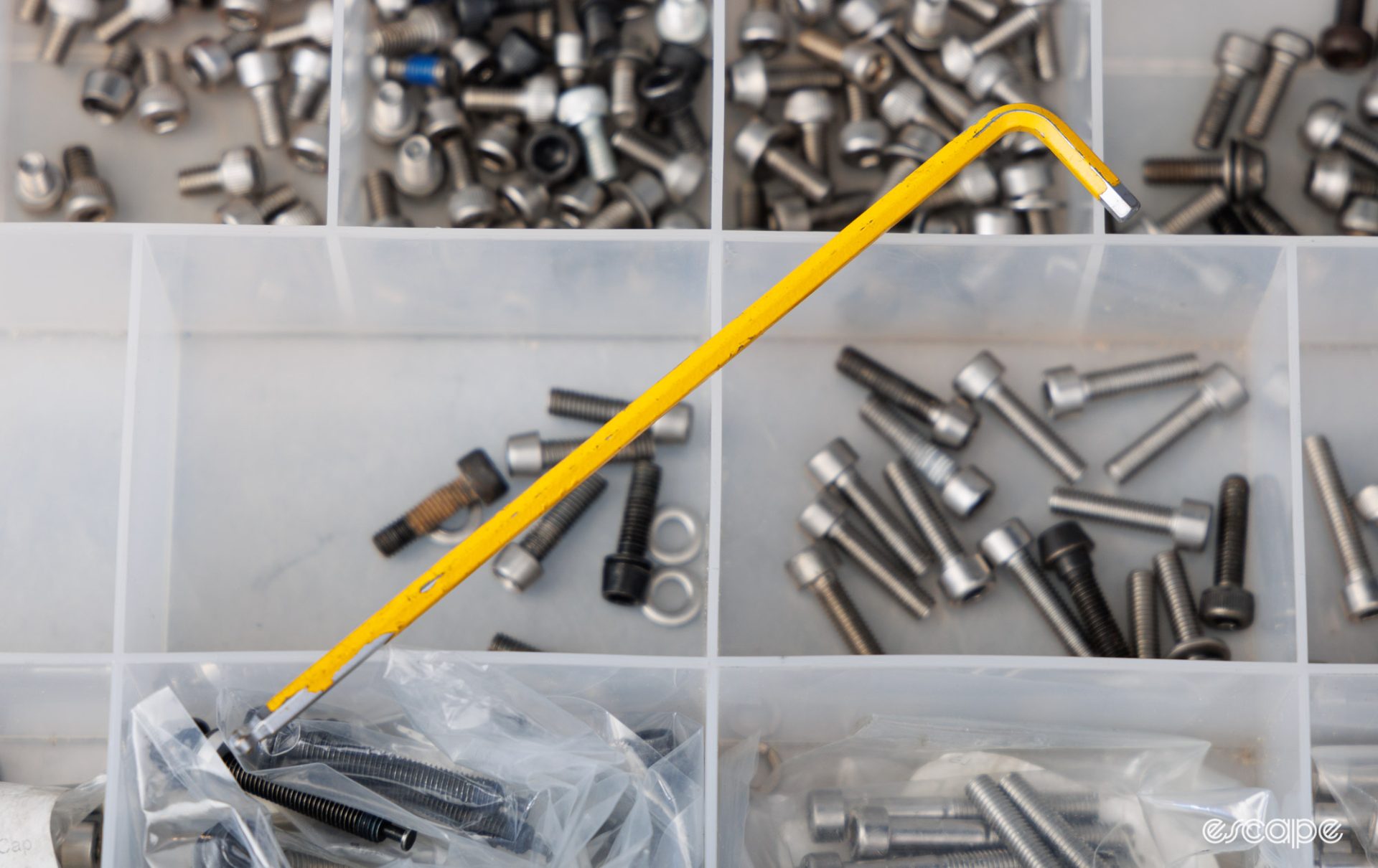
I use PB Swiss 212-LH long keys with a ball-end. The steel is ultra-long-lasting, it has a nice tactile spring, and doesn’t rust. The consistent fit dimensions fit into oversized and undersized fasteners, and the ball-ends are some of the best in not rounding fasteners.
If you can’t afford these, check out Bondhus BriteGuard and Wiha 66980. Wera is another popular pick, although the patented HexPlus design can dig into crappy soft fasteners in sizes of 4 mm or smaller. A bonus to all of these higher-end suggestions is you can buy replacements in individual sizes.
These keys are colour-coded for easy identification, something PB Swiss was first to do, and they’re colours I’ve carried onto many other hex tools.
2. 1/4″ ratchet
When it comes to ratchets, if I can’t have a high tooth count, low backdrag (breakaway resistance to ratchet), and a thumb spinner then I don’t want one at all. Being able to check this list means they’re perhaps my most used tool and I have a handful of them to save time in switching bit sockets.
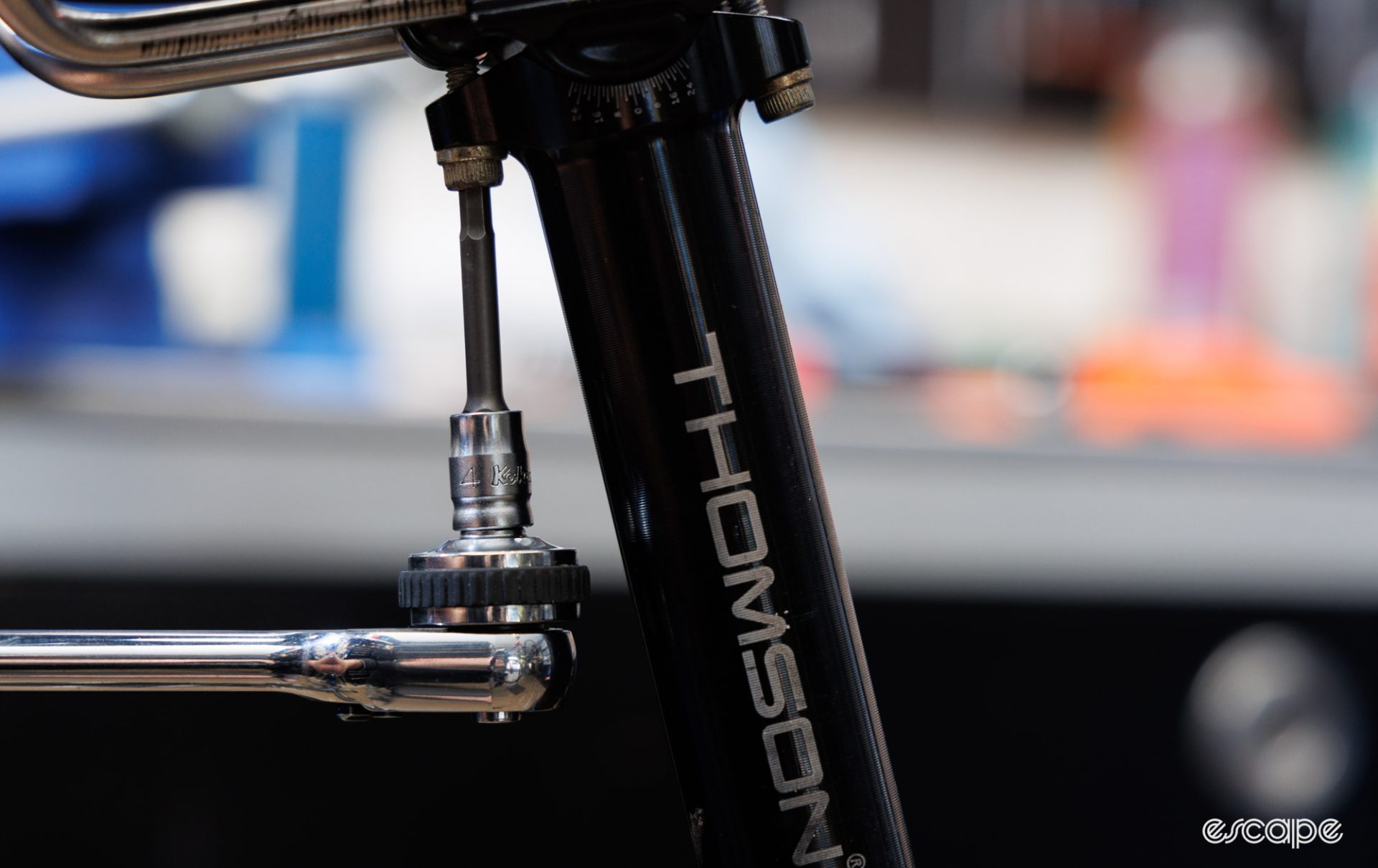
My two favourite ratchets are the Nepros (long handle) and Snap-On THL72. Neither are low in cost, but I’m yet to find lower-cost options that meet my requirements (including Icon, Gearwrench, Koken, Facom, Wera – the list goes on). Because of its narrower head design, the Nepros is what I use with a 4 mm hex socket.
I’ve tried many 1/4″ hex bit sockets over the years, but right now my favourite 4 mm is a Koken Zeal 50 mm (#2010MZ.50). The fit is good, it has proven durable, and its medium length enables better clearance in many seatposts and around stems. Sitting between that socket and ratchet is a Nepros Quick Spinner, something that allows me to quickly spin the socket until there’s enough resistance on the thread to use the ratchet one-handed.
3. Cross-handle
Ever tried adjusting a flat mount road/gravel disc brake only to find yourself bumping into the rotor and/or chainstay? Or how about tightening the bolts on a stem faceplate that has a computer mount in the way? In these scenarios I reach for a cross-handle driver.
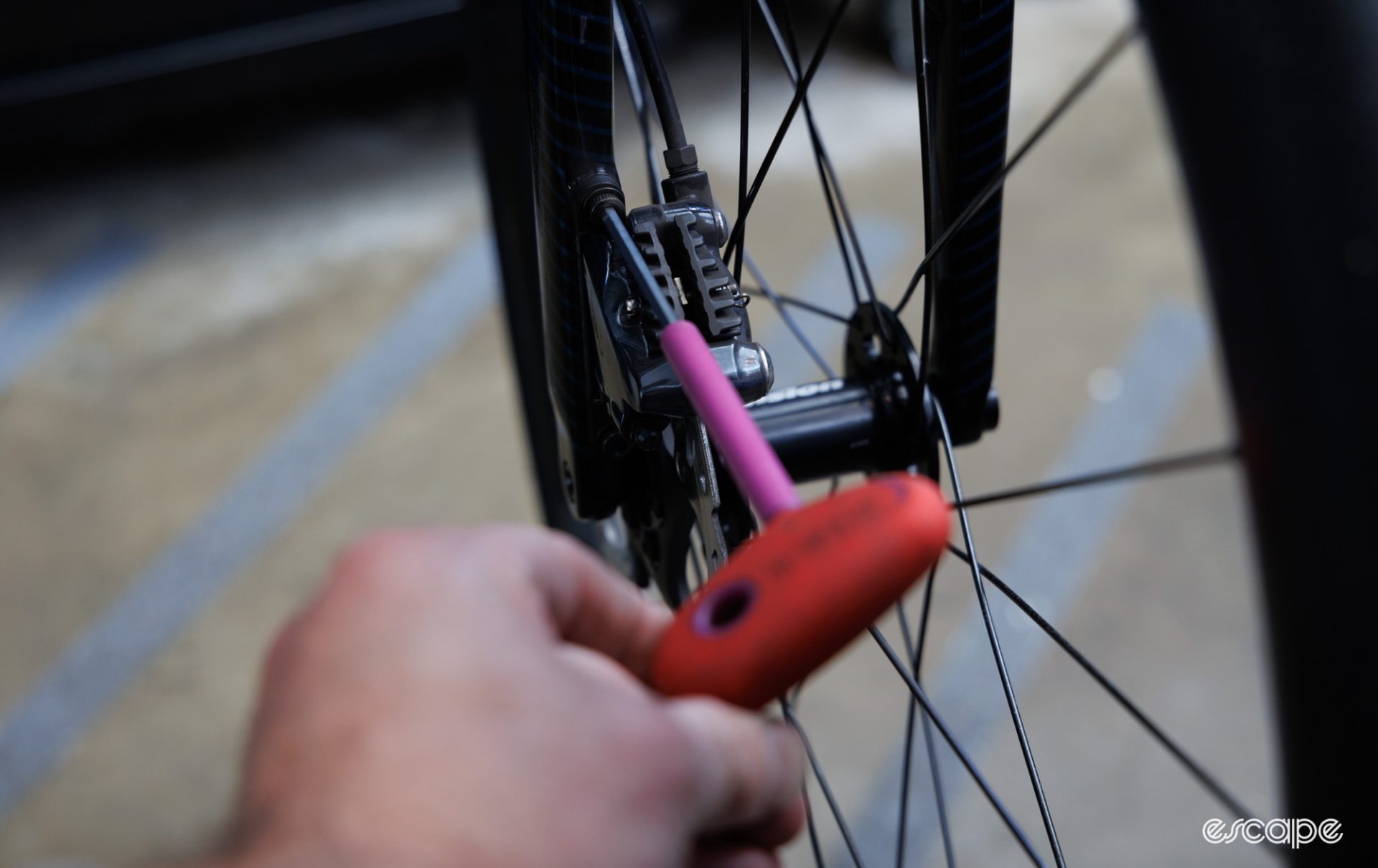
OK, I promise I’m not a paid influencer for PB Swiss (I bought all of these!), but this tool style does seem to be unique to them. The attributes of such a tool are a long straight hex blade and an ergonomic yet narrow handle. The PB Swiss PB207-L 150 ticks these boxes. It’s a tool where I only use the 4 and 5 mm sizes (at least in this longer 150 mm blade length).
4. Electric screwdriver
Call me lazy but a small USB-rechargeable electric screwdriver has proven a game-changer when dealing with repeated long-threaded fasteners, such as when installing bidon cages, changing stems, or building Ikea furniture (a chest of drawers to store your bibs is cycling related …)
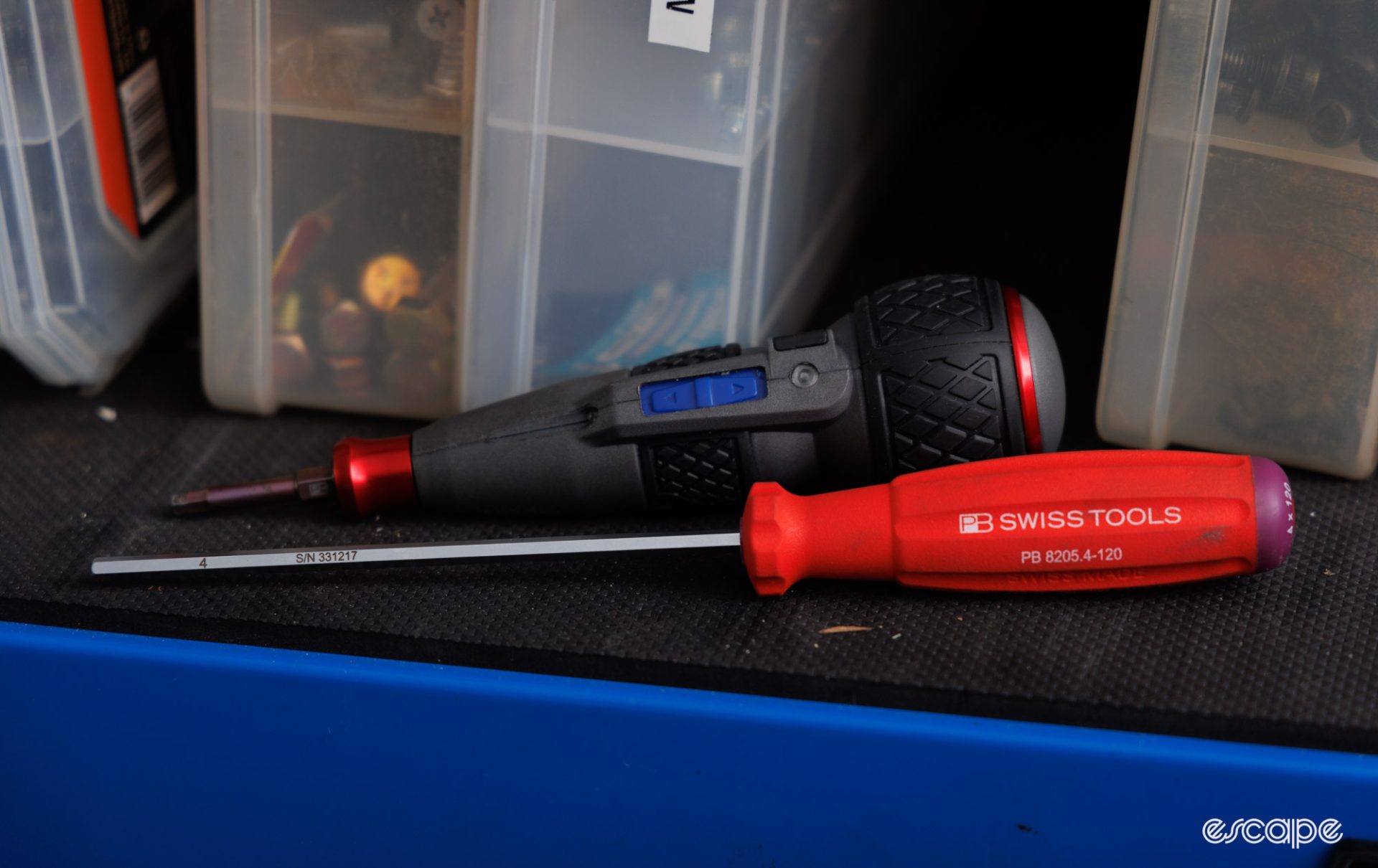
The Vessel 220 USB Plus is the clear winner in this category for how it feels and works just like a regular screwdriver. The added zip comes when you slide the button forward (clockwise tightening) or backward (anti-clockwise). And with the tool running out of steam near to 3 Nm there’s little risk of over-tightening things. I keep a PB Swiss C6 bit in it for the 4 mm stuff, but this tool also sees use in lacing wheels.
5. Screwdriver
Not a fan of zoom-zoom electric tools? A hex screwdriver is something I often reach for in sizes below 4 mm. In a 4 mm size these are the perfect tool for bottle cage bolts. A ball-end can be helpful in this size, but I’d avoid such a feature in anything smaller. My go-to is the PB Swiss 8205 (seen in the above image), but Bondhus also does a good one at a fraction of the price.
6. Preset torque driver
Torque wrenches are a whole different category of tool that deserve a much deeper dive, however for 4 mm hex I find myself predominately using a preset driver in either 4, 5, or 6 Nm torques. The Pedro’s Fixed Torque Driver is my favourite due to its comfortable shaping and reassuring cam-over design (prevents accidental over-torque). Meanwhile, my top-value pick goes to PrestaCycle, and as a bonus, its simpler design is safe to undo fasteners with.
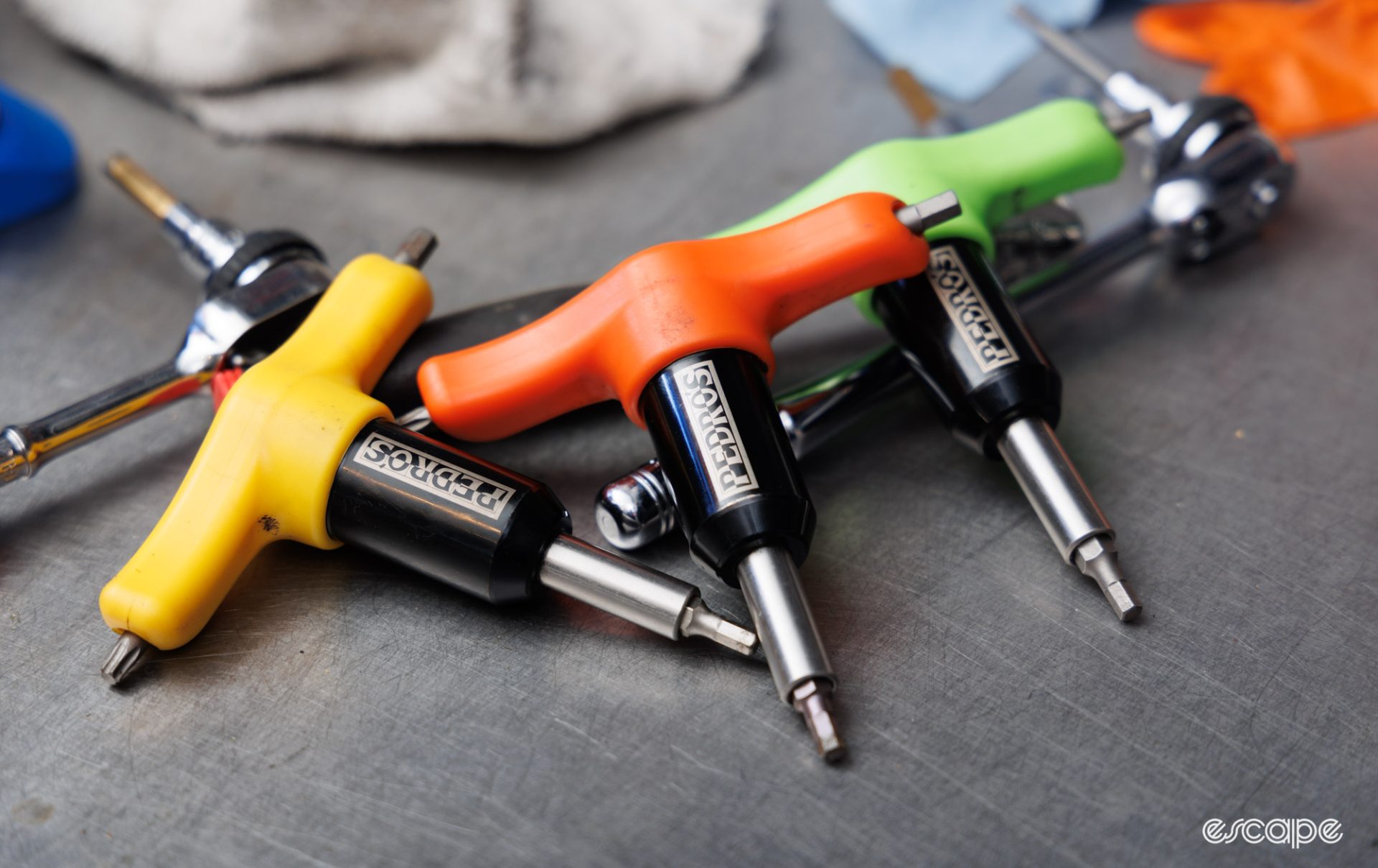
Most of the time, I use these tools with a regular short bit (again, PB Swiss C6), but sometimes I’ll use a 100 mm length bit where extended reach is needed (such as with a computer mount in the way of the stem bolts). Both Vessel and PrestaCycle offer good-value long hex bits for this rarer task.
7. Bit ratchet
Sometimes a regular ratchet is too cumbersome, and that’s where the far smaller 1/4″ bit-ratchet comes in. You can build most of a bike with one of these, it’s just in a workshop setting I prefer more ergonomic options.
There are lots of good options here, many of which are from the same Taiwanese manufacturer. With a longer handle and a compact head, my current favourite style is available under a number of brands, but PrestaCycle typically has it for the best price. Combine with the same bit suggestions as the torque driver above.
8. Stubby L Key
Sometimes regular hex keys just can’t get into wherever the fastener is. On bicycles this is usually the result of dumb design, and so you can bet it exists. Imagine taking a hacksaw to the short end of a L-key – that’s exactly what a Stubby hex key is. My preference is yet again for PB Swiss (2212 L), except this time it’s because they angle the key to give better clearance than if it were a perfect 90º bend.

There are also bit ratchets that serve similar purposes, although do require more space around the bolt to use. My recently acquired BGS low profile ratchet has the lowest stack of any bit ratchet.
9. P-Handle
With an ergonomic handle and great leverage, the P-Handle is a common sight in bicycle workshops. I don’t often use this style in sizes smaller than 4 mm, and really, even the 4 mm is rarely used because the handle can feel cumbersome at such low torque demands.
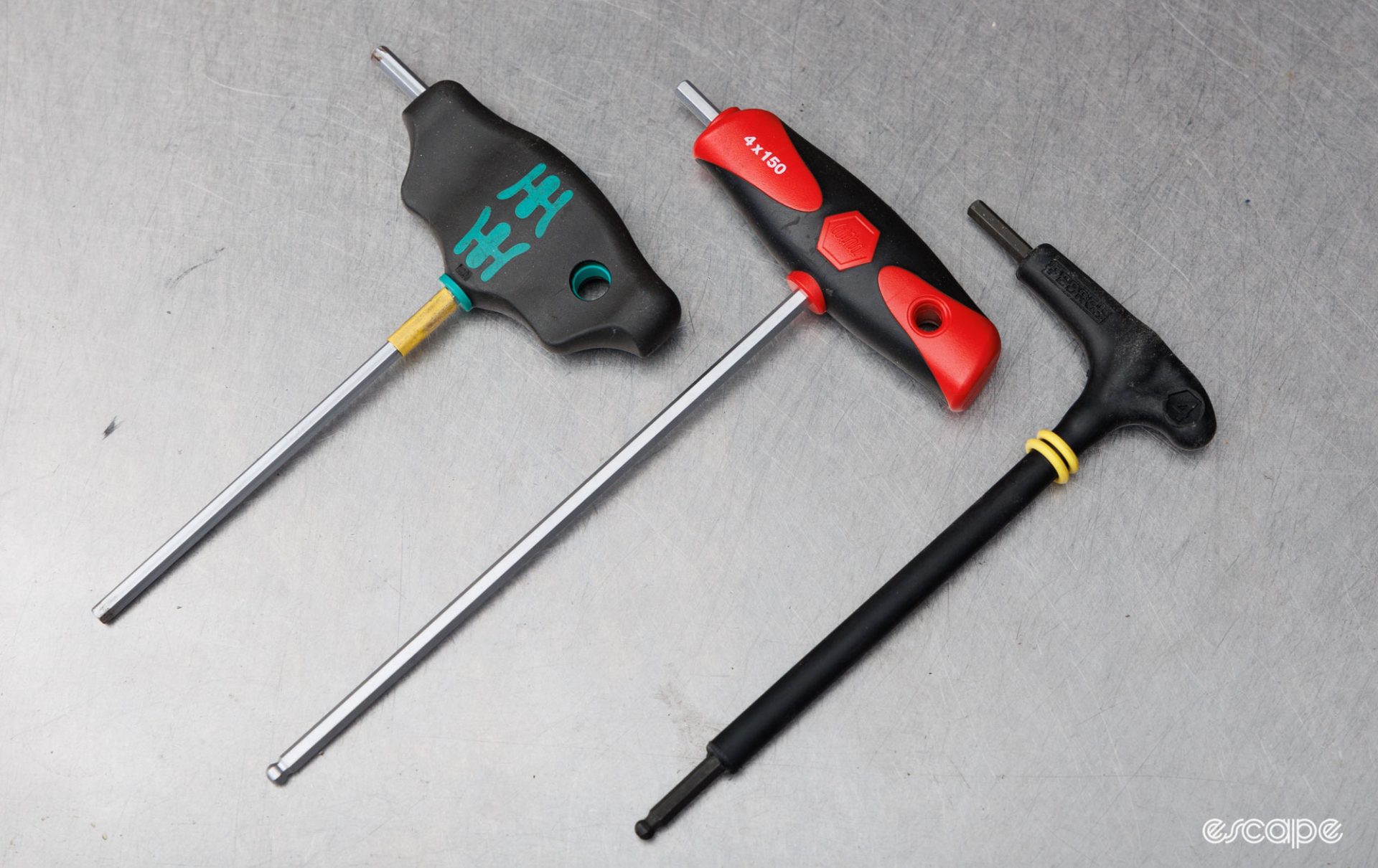
Quick tangent: I use this style quite a lot in 5, 6, and 8 mm sizes where the leverage and handle size are of benefit. I also keep a 5 mm P-handle with a ball-end near as it’s the perfect tool for adjusting most dropbar brake lever hoods (Wiha, Park Tool, and PB Swiss are my faves).
10. Sliding T-handle
Bringing more comfort, leverage, and spinning weight to the L-key design, sliding T-handles are popular among professionals. However, it’s important to know that the bulbous T junction means they’re not a replacement for owning a set of L keys.
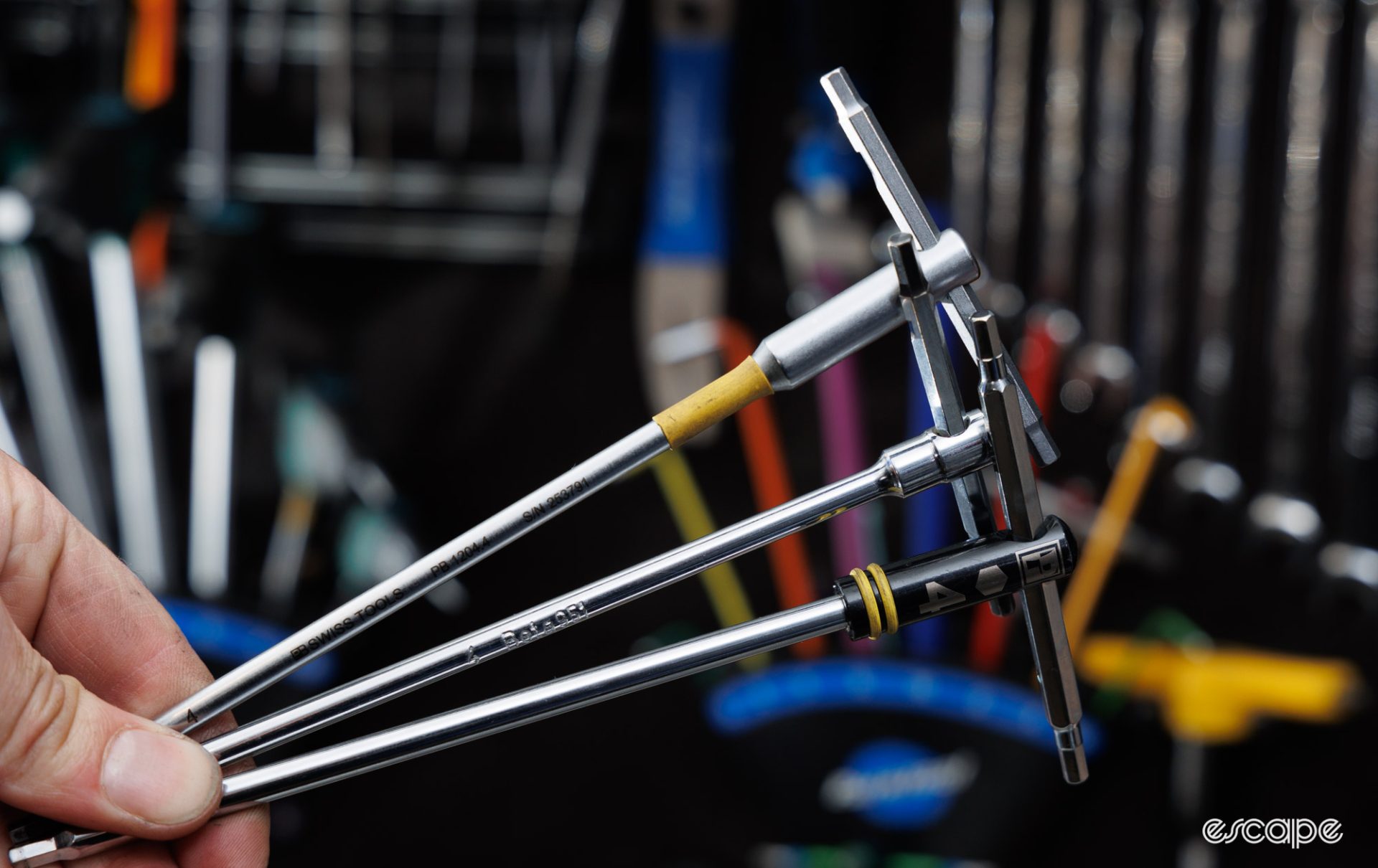
I prefer the Cross-Handle drivers (above) over a Sliding T-handle, but many of you seem set on using these so here it goes. Most sliding T-handles are produced by the same Taiwanese manufacturer with only subtle differences. The three that stand out for the better, and in order of my preference, are the PB Swiss 1204, the Beta 951 (the original!), and the new Pedro’s Master T-Handle II.
11. The rest
Fringe cases have me reaching for other 4 mm hex keys. If already in my hands, I’ll use an Abbey Bike Tools Four-Way for low-torque needs. And even more rarely, when straight-on access is needed, but the working height is limited, you may see me reach for a short-handled L key from Bondhus or Wera.
OK, so that was the first taste of my approach to bicycle repair. Good organisation makes all the difference in ensuring having so many tools is quicker and not a pointless endeavour. Meanwhile experience will have you picking up the most suitable tool without conscious thought or faff.
Threaded will return in two weeks. If you liked this, please subscribe to ensure you don’t miss future editions, and share it with any friends who may like it.
What did you think of this story?

